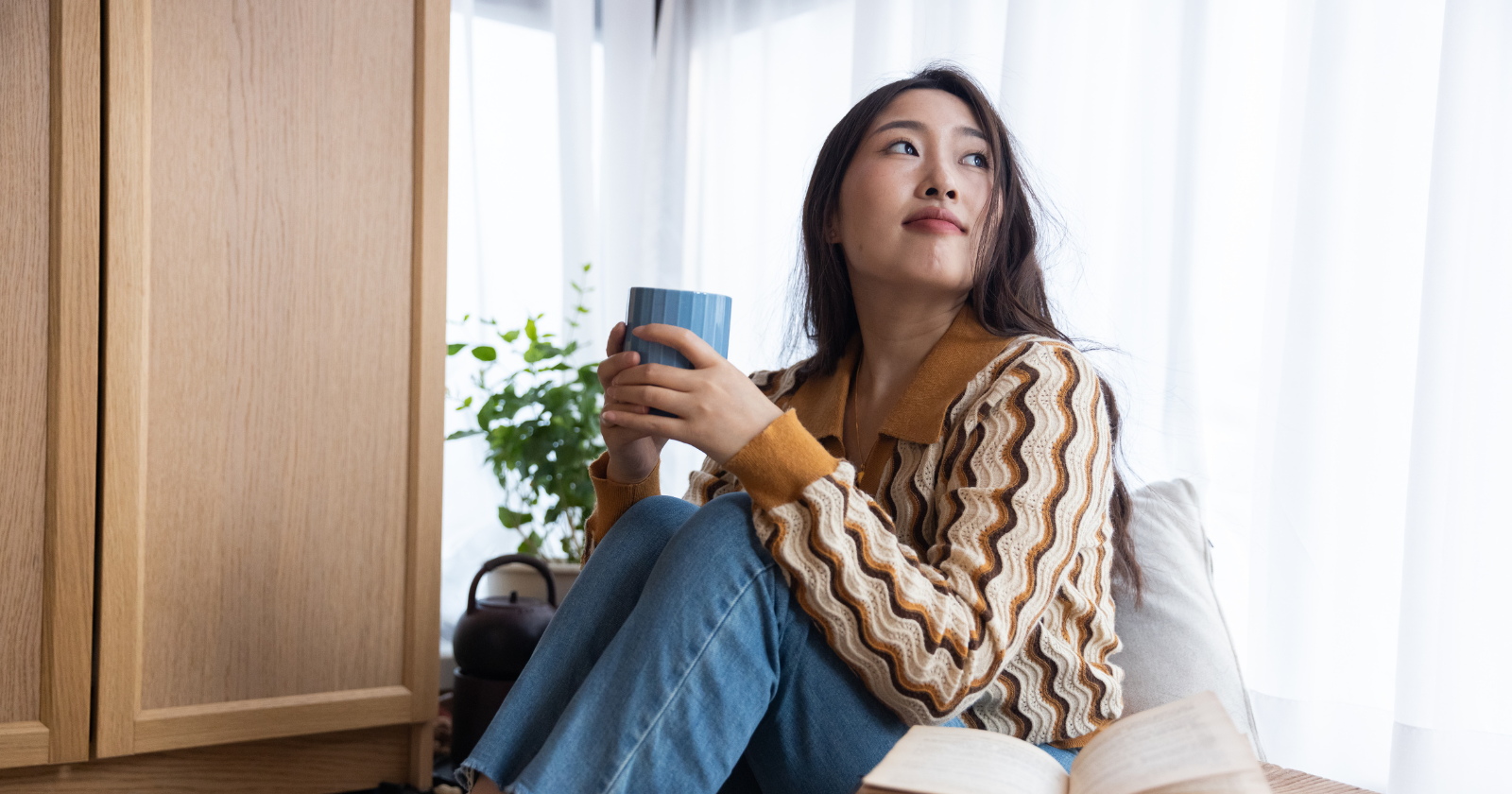There’s a profound difference between being happy alone and just being lonely. And if you’ve ever felt that distinction in your own life, you know it’s not about how much time you spend by yourself—it’s about how you experience that time.
Some people seem to genuinely thrive in solitude. They emerge from alone time refreshed, creative, and more connected to themselves. Others dread it, filling every quiet moment with distractions or feeling an aching emptiness they can’t quite shake.
The difference isn’t random. People who are genuinely happy alone approach solitude differently than those who are just lonely. They’ve developed specific habits and mindsets that transform alone time from something to endure into something that nourishes them.
If you’ve been struggling with your own company, these seven differences might shine a light on what’s possible when you shift your relationship with solitude.
1) They create intentional rituals around their alone time
People who are happy alone don’t just stumble into solitude—they shape it deliberately.
They might light a candle before settling in to read. They might always make tea in the same mug before writing. They might have a specific playlist for solo walks or a particular chair where they do their thinking.
These rituals aren’t about being precious or performative. They’re signals to your brain that this time matters. They create a sense of sacredness around solitude that transforms it from empty space into intentional practice.
The lonely person treats alone time like something that happens to them—unwanted and unstructured. The content person treats it like an appointment with themselves that deserves attention and care.
Even simple rituals work: opening a window for fresh air, putting on comfortable clothes, clearing a specific space. The act of preparation communicates to yourself that your own company is worth preparing for.
2) They’ve learned to sit with uncomfortable feelings instead of numbing them
Here’s what nobody tells you about being alone: sometimes it brings up feelings you’d rather not face.
When you remove all the noise and distraction—the scrolling, the television, the constant connection—you’re left with whatever’s been sitting underneath. Sometimes that’s anxiety. Sometimes it’s grief. Sometimes it’s just an uncomfortable restlessness that has no name.
Related Stories from The Artful Parent
People who genuinely enjoy solitude have learned something crucial: they can feel uncomfortable emotions without immediately trying to fix or escape them.
They don’t reach for their phone the moment they feel bored. They don’t turn on background noise to drown out their thoughts. They sit with what arises, observe it, and let it pass.
This doesn’t mean they enjoy discomfort. It means they’ve developed the capacity to tolerate it—to recognize that feelings are temporary and that being uncomfortable isn’t the same as being in danger.
The lonely person fills every quiet moment because silence feels threatening. The content person has learned that silence is where the real work of understanding yourself happens.
3) They pursue activities that genuinely interest them, not just what looks good
Genuine happiness in solitude comes from doing things you actually love, regardless of how they appear to anyone else.
This might be organizing your bookshelf by color or subject. It might be making elaborate meals for one. It might be tending to houseplants, learning a language through an app, or spending hours on a hobby that produces nothing impressive.
- If you still read physical books instead of e-readers, psychology says you possess these 9 characteristics - Global English Editing
- Women who are deeply unhappy with their own lives usually display these traits without realizing it - Global English Editing
- 8 things working-class families do at restaurants that servers appreciate immensely - Global English Editing
The key is authenticity. People who are happy alone have figured out what genuinely lights them up, and they pursue those things without needing external validation.
They’re not performing solitude for social media. They’re not choosing activities because they seem like the “right” way to spend alone time. They’re following their actual curiosity and interests wherever they lead.
This requires knowing yourself well enough to distinguish between what you think you should enjoy and what actually brings you satisfaction. That self-knowledge only comes from spending time with yourself—without judgment.
4) They maintain a sense of connection even while physically alone
This might sound contradictory, but the happiest alone people aren’t actually disconnected from others.
They might think about friends while doing activities alone. They might feel part of a larger community even when no one else is physically present. They maintain a sense of belonging that doesn’t require constant physical proximity.
Solitude, for them, isn’t about cutting themselves off—it’s about deepening their capacity for connection by staying connected to themselves first.
They also stay tethered to their people in meaningful ways. They have relationships that feel secure enough that physical absence doesn’t trigger anxiety. They know they can reach out when they want to, which paradoxically makes alone time feel safer.
The key difference? Lonely people feel cut off even in a crowd. Content people maintain emotional connection even when they’re physically alone.
This sense of connection might also extend beyond relationships. Some people feel connected to nature, to creative work, to ideas they’re exploring, or to something spiritual that sustains them through solitary hours.
5) They’ve developed a practice of self-compassion
Want to know the fastest way to make alone time miserable? Beat yourself up the entire time.
People who are genuinely happy alone have learned to speak to themselves with kindness. They’ve cultivated an inner voice that’s encouraging rather than critical, patient rather than harsh.
When they make mistakes or fall short of their own expectations, they respond the way they would to a friend—with understanding and gentleness. They don’t use solitude as an opportunity to rehearse all their failures or catalog their inadequacies.
This doesn’t mean they avoid accountability or never push themselves to grow. It means they’ve learned that shame and criticism don’t actually motivate positive change. Compassion does.
They understand that perfection isn’t the goal. Being human is. And being human means sometimes struggling, sometimes failing, sometimes just existing without achievement—and that’s okay.
The lonely person uses alone time to spiral into self-criticism. The content person uses it to practice being kind to the person they spend the most time with: themselves.
6) They balance alone time with meaningful social connection
Here’s the thing about being happy alone: it requires actually having connection in your life to balance it.
True solitude is chosen, not imposed. And the ability to choose it depends on having relationships that sustain you when you’re not alone.
People who genuinely thrive in solitude aren’t hermits. They’ve intentionally built a life with meaningful relationships—friendships, family bonds, community connections—that provide the social nourishment humans need.
The alone time then becomes restorative rather than depleting. It’s a break from connection, not an absence of it.
When someone is chronically isolated—when they don’t have meaningful relationships in their life—alone time doesn’t feel the same. It feels heavier. More desperate. Less like a choice and more like a sentence.
You need both. The richness of connection makes solitude sweet. The restoration of solitude makes you better at connection.
The balance looks different for everyone. Some people need more social time, others less. But everyone needs some of both to thrive.
7) They actively nurture their inner world
The people who are happiest alone have something that lonely people often lack: a rich inner landscape.
They read voraciously and think about ideas. They have creative pursuits that engage their imagination. They develop interests that don’t require another person to be interesting.
They’ve cultivated curiosity about the world and about themselves. They ask questions, explore topics that fascinate them, and build knowledge in areas that matter to them personally—not professionally or socially, but genuinely.
This inner richness means they always have something to think about, work on, or explore. Their minds are interesting places to spend time.
Lonely people often have empty inner lives that make solitude feel terrifying—like being trapped in a room with nothing to do. Content people have cultivated internal richness that makes their own company genuinely enjoyable.
This isn’t about intelligence or education. It’s about engagement with life. It’s about staying curious and interested rather than passive and disconnected.
When you have a vibrant inner world, being alone doesn’t feel like deprivation. It feels like an opportunity to engage with all the ideas, projects, and questions that live inside you.
Conclusion
The path from loneliness to contentment in solitude isn’t about becoming a hermit or rejecting connection. It’s about developing a relationship with yourself that’s as nourishing as your relationships with others.
It’s about learning that your own company doesn’t have to feel like punishment. That alone time can be restorative rather than depleting. That solitude is something you can shape intentionally rather than something that just happens to you.
None of this is easy, and it doesn’t happen overnight. Building comfort with solitude is a practice, and like any practice, it requires patience and repetition.
But it’s worth it. Because when you learn to be genuinely happy alone, you stop being desperate for connection in ways that compromise your well-being. You choose relationships from a place of desire rather than need. You bring a fuller, more grounded version of yourself to every interaction.
And perhaps most importantly, you discover that you’re actually pretty good company—when you give yourself a chance.



